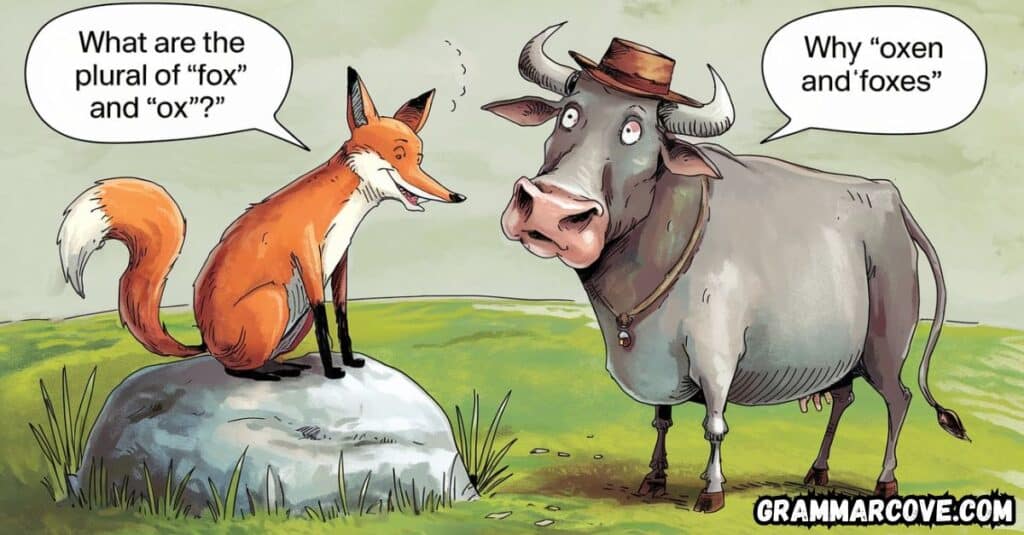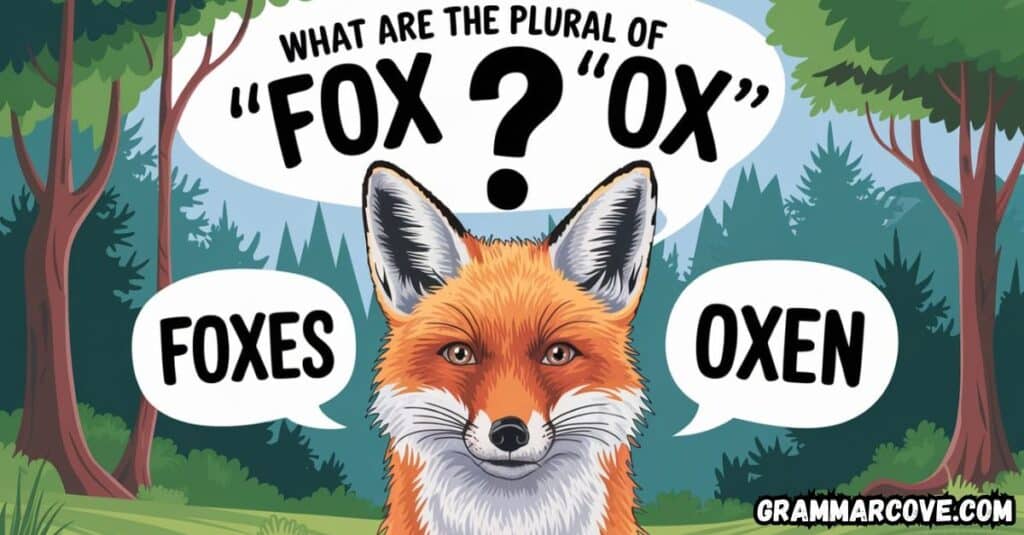English is a fascinating language full of peculiarities, and the plurals of certain words stand out as exceptions to the usual rules. One such example is the plural of fox, which becomes “foxes” instead of following the typical “es” pattern. This unique form, along with other irregular plurals like “ox,” often causes confusion for English learners and even native speakers.
In this article, we will explore why the plural of fox is “foxes,” while the plural form of ox is “oxen,” and delve into the history and rules behind these changes. Along the way, we’ll provide scenarios and examples to make the differences clearer.
The Singular Forms of “Ox” and “Fox”
Before we dive into the plural forms, let’s first establish the singular versions of the words we’re working with. As you know, ox is a domesticated animal commonly used for farm labor, while fox is a wild animal known for its cunning nature.
- Ox: The singular form refers to a large, domesticated bovine typically used for pulling carts, plows, or carrying heavy loads. It’s a term that has been used for centuries and has its roots in Old English.
- Fox: This singular form refers to the wild mammal, known for its bushy tail and clever traits. Foxes have captured our imagination through folklore, stories, and even as a symbol of cleverness and trickery.
Let’s now look at how these words change when they become plural.

The Plural Form of Ox: Why “Oxen”?
The plural of ox isn’t simply “oxs” or “oxes,” as one might expect based on English language patterns. Instead, it’s oxen. This is a great example of how English, like many other languages, doesn’t always follow easy-to-understand rules, especially when dealing with irregular nouns.
Why is the Plural “Oxen”?
The word oxen singular form originates from Old English, where the word “ox” was a more general term for cattle or any bovine animal. During this time, the plural was formed with the suffix “-en” rather than the more modern “-s” or “-es.” This change can be traced back to the way Old English had specific endings for plurals, especially for certain categories of nouns.
Historically, oxen was used as the plural not only of “ox” but also for other similar terms. While the usage of “oxen” today is limited primarily to the domesticated bovine, the “-en” suffix in Old English was a common way of creating plurals for specific words.
Let’s take a look at a scenario where the plural form of ox is used:
Scenario 1: Email about Farm Animals
Subject: Request for Additional Oxen on the Farm
Hi Sarah,
I hope you’re doing well! I wanted to check in about our current farm operations. We have two oxen pulling the plow, but I think we might need a few more to increase efficiency. Could you look into purchasing additional oxen? I’d love to see how it affects our productivity.
Thanks, and let me know if you need any more information.
Best regards,
James
In this scenario, “oxen” is used correctly to refer to more than one ox, highlighting the traditional plural form. The use of “oxen” gives the sentence an almost historical feel, showing how English has preserved some of its ancient grammatical structures.
The Plural of Fox: Why “Foxes”?
The word foxes, on the other hand, follows a more typical pattern for pluralization in English. To make a word ending in “-x” plural, we simply add “-es,” as we do with many other nouns in the language.
Thus, the plural of fox is foxes.
Why “Foxes”?
The plural form foxes follows the rule where words ending in “x” take “-es” to form the plural. This rule helps maintain the integrity of the pronunciation. Think about how saying “foxes” sounds more natural than “foxs,” which would be hard to pronounce smoothly.
For example, consider this scenario:
Scenario 2: Email about Fox Sightings
Subject: Foxes Spotted in the Neighborhood
Hi Tom,
I just wanted to let you know that a few foxes have been spotted in the neighborhood recently. We’ve seen them darting across the streets during the evening, and there’s even a den near the old oak tree. It’s pretty exciting, though I’m a little concerned about the safety of pets in the area.
Let me know if you need any more information.
Cheers,
Emily
In this email, “foxes” is the standard plural form, showing the simple rule of adding “-es” to words ending in “x.” The word flows naturally, and the usage follows modern English conventions.
Why Do “Ox” and “Fox” Have Different Plural Forms?
Now that we’ve established the plurals, you might wonder: Why do “ox” and “fox” have different plural forms? After all, they both seem to belong to similar categories of animals. The answer lies in the historical development of the English language.
Oxen: A Remnant of Old English
The plural form “oxen” is a remnant of an older time when English had different rules for pluralization. The Old English language had more diverse ways to form plurals, especially with certain nouns. The “-en” ending was used for a number of words, including “ox,” to indicate the plural.
As the language evolved, many of these plurals were simplified. Most words switched to the modern plural form ending in “-s” or “-es.” However, some words like oxen and a few others (such as “children” and “men”) kept their old forms. The word “oxen” thus serves as a reminder of these earlier stages in the evolution of English.
Foxes: A Regular Pluralization
On the other hand, “fox” follows a much more regular pluralization rule. The suffix “-es” is added to words ending in “x,” “s,” “z,” and similar sounds to make the plural form. “Foxes” follows this pattern, which is why it sounds more modern and familiar.
A Quick Comparison: Oxen vs. Foxes
Here’s a simple table to highlight the differences between the two plurals:
| Singular Form | Plural Form | Reason for Pluralization |
|---|---|---|
| Ox | Oxen | Derived from Old English, using the “-en” plural suffix |
| Fox | Foxes | Regular pluralization, adding “-es” for words ending in “x” |
This table neatly shows the distinction between these two plurals. One is an irregular holdover from an earlier time, while the other follows a more typical rule.
Conclusion
In conclusion, while both ox plural word and fox plural form refer to animals, their plurals follow different rules due to historical and linguistic reasons. Oxen singular form comes from Old English, where certain nouns took the “-en” suffix in the plural, while foxes simply follows the regular pluralization rule for words ending in “x.”
As you continue to use these words in your writing or speaking, remember the unique plurals and their roots in the language’s history. Whether you’re talking about a herd of oxen or a group of foxes, understanding the origins of these words will help you appreciate the quirks of English grammar.


